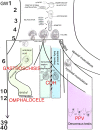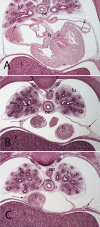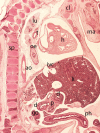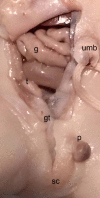Embryology of the Abdominal Wall and Associated Malformations-A Review
- PMID: 35874129
- PMCID: PMC9300894
- DOI: 10.3389/fsurg.2022.891896
Embryology of the Abdominal Wall and Associated Malformations-A Review
Abstract
In humans, the incidence of congenital defects of the intraembryonic celom and its associated structures has increased over recent decades. Surgical treatment of abdominal and diaphragmatic malformations resulting in congenital hernia requires deep knowledge of ventral body closure and the separation of the primary body cavities during embryogenesis. The correct development of both structures requires the coordinated and fine-tuned synergy of different anlagen, including a set of molecules governing those processes. They have mainly been investigated in a range of vertebrate species (e.g., mouse, birds, and fish), but studies of embryogenesis in humans are rather rare because samples are seldom available. Therefore, we have to deal with a large body of conflicting data concerning the formation of the abdominal wall and the etiology of diaphragmatic defects. This review summarizes the current state of knowledge and focuses on the histological and molecular events leading to the establishment of the abdominal and thoracic cavities in several vertebrate species. In chronological order, we start with the onset of gastrulation, continue with the establishment of the three-dimensional body shape, and end with the partition of body cavities. We also discuss well-known human etiologies.
Keywords: abdominal wall; congenital hernia; developmental cascade; embryology; human.
Copyright © 2022 Pechriggl, Blumer, Tubbs, Olewnik, Konschake, Fortelny, Stofferin, Honis, Quinones, Maranillo and Sanudo.
Conflict of interest statement
The authors declare that the research was conducted in the absence of any commercial or financial relationships that could be construed as a potential conflict of interest.
Figures















Similar articles
-
Finally, a sense of closure? Animal models of human ventral body wall defects.Bioessays. 2004 Dec;26(12):1307-21. doi: 10.1002/bies.20137. Bioessays. 2004. PMID: 15551266 Review.
-
The split abdominal wall muscle flap--a simple, mesh-free approach to repair large diaphragmatic hernia.J Pediatr Surg. 2003 Dec;38(12):1748-51. doi: 10.1016/j.jpedsurg.2003.08.045. J Pediatr Surg. 2003. PMID: 14666458
-
Coexistence of congenital diaphragmatic hernia and abdominal wall closure defect with chromosomal abnormality: two case reports.J Med Case Rep. 2016 Jan 22;10:19. doi: 10.1186/s13256-016-0805-y. J Med Case Rep. 2016. PMID: 26800685 Free PMC article.
-
When Closure Fails: What the Radiologist Needs to Know About the Embryology, Anatomy, and Prenatal Imaging of Ventral Body Wall Defects.Semin Ultrasound CT MR. 2015 Dec;36(6):522-36. doi: 10.1053/j.sult.2015.01.001. Epub 2015 Jan 14. Semin Ultrasound CT MR. 2015. PMID: 26614134 Review.
-
Insights into embryology and development of omphalocele.Semin Pediatr Surg. 2019 Apr;28(2):80-83. doi: 10.1053/j.sempedsurg.2019.04.003. Epub 2019 Apr 6. Semin Pediatr Surg. 2019. PMID: 31072462 Review.
Cited by
-
Left side appendiceal abscess in a patient with intestinal nonrotation: Case report.Radiol Case Rep. 2024 Aug 3;19(10):4513-4516. doi: 10.1016/j.radcr.2024.07.049. eCollection 2024 Oct. Radiol Case Rep. 2024. PMID: 39188626 Free PMC article.
-
Y-27632 Impairs Angiogenesis on Extra-Embryonic Vasculature in Post-Gastrulation Chick Embryos.Toxics. 2023 Jan 30;11(2):134. doi: 10.3390/toxics11020134. Toxics. 2023. PMID: 36851009 Free PMC article.
-
Giant omphalocele: A novel approach for primary repair in the neonatal period using botulinum toxin.Rev Col Bras Cir. 2023 Nov 20;50:e20233582. doi: 10.1590/0100-6991e-20233582-en. eCollection 2023. Rev Col Bras Cir. 2023. PMID: 37991062 Free PMC article.
-
The Interplay of Molecular Factors and Morphology in Human Placental Development and Implantation.Biomedicines. 2024 Dec 20;12(12):2908. doi: 10.3390/biomedicines12122908. Biomedicines. 2024. PMID: 39767812 Free PMC article. Review.
References
-
- Torres US, Portela-Oliveira E, Braga Fdel C, Werner H, Jr, Daltro PA, Souza AS. When closure fails: what the radiologist needs to know about the embryology, anatomy, and prenatal imaging of ventral body wall defects. Semin Ultrasound CT MR. (2015) 36(6):522–36. 10.1053/j.sult.2015.01.001 - DOI - PubMed
Publication types
LinkOut - more resources
Full Text Sources

